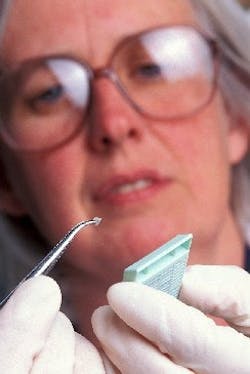In July, the U.S. Food and Drug Administration issued a final interim rule limiting the types of animal-derived materials that can be used to manufacture animal feed, cosmetics, and food supplements. The rule aims to protect humans and livestock from abnormal prions (Graphics), proteins that are found in many animal species, but which, in abnormal form, have been associated with fatal neurological conditions. Materials including gelatin, keratin and tallow, whose derivatives include fatty acids and glycerin, come from cattle and other livestock. The new rule, which will be finalized in October, would forbid manufacturers from using raw materials made from brain, skull, spinal cord, and other designated parts of cattle 30 months of age and older, and would set an impurity ceiling of 0.15% for tallow. The rule does not explicitly cover pharmaceuticals or set any validation requirements for biopharmaceutical manufacturing. Currently, the Atlanta-based biotech firm Serologicals Corp.estimates that over $20 billion worth of biotech products, representing over 60% of pharmaceuticals now on the market, use bovine derivatives at some point in their development or production. They include: ? Monoclonal antibodies, which use bovine serum as a nutrient? Human plasma derivatives such as gamma globulin? Insulin, heparin, and bovine pituitary hormones. A 1996 study by the U.K. U.S. Canada UK Europe , where over 150 cases of BSE have been documented, regulatory agencies have mandated removal of prions from blood products, via white blood cell filtration, and manufacturers can make the claim that their products are "prion-free" on their labels. The European Union has codified standards for use of animal derivative materials, as has Japan East Hills , N.Y. Annapolis , Md.; http://www.pptaglobal.org), which represents plasma protein drug manufacturers. U.S. Canada U.S. Cincinnati Mentor , Ohio Europe , to evaluate the prion-removal effectiveness of existing cleaning procedures. In the meantime, a number of effective new procedures are being developed. (For information on one case history, see http://www.invitrogen.com/content.cfm?pageid=4287Chemical, Physical DeactivationThe trouble with existing prion deactivation processes is that many of them operate at conditions that would deactivate protein products, too. Safer alternatives are being developed, though. Serologicals Corp. is using its purification process internally and, at this time, has no plans to license the process. However, Genencor International (Rochester U.K. Europe for surgical and dental instrument sterilization.Filtration SolutionsIn plasma manufacturing, Martin says, charge-depth and viral filtration can be used to remove prions, as can membrane chromatography. However, viral filtration can only remove prions that have aggregated. Ion-exchange column chromatography can be used to remove individual prions, but the columns must be cleaned thoroughly to ensure product safety. As an alternative to column chromatography, Pall has developed disposable Mustang chromatography systems using microporous membranes. Assuming a 50-L column and 100-L batch size, the company estimates that use of Mustang chromatography units would save manufacturers $3,100 per cycle compared with ion-exchange chromatography columns.So far, Pall's Ultipor VF grade DV20 and DV50 filters have been shown to be effective for removing more than four logs, or over 99.99%, of prion proteins. The European Agency for the Evaluation of Medicinal Products has approved the use of Ultipor DV 50 virus filters to remove prions from Redimune immunoglobulin, which is made by ZLB Behring AG (Bern , Switzerland
Shown here, a "normal" prion molecule. In abnormal proteins, the "tail" portion of the protein molecule folds in on itself
Sheep infected with Scrapie, so called because it causes them to itch intensely, and scrape their sides against fences, have been found to be a source of BSE and related diseases in humans. Shown here, a sheep with Scrapie
A USDA scientist uses a new diagnostic test to determine whether prions are present in a sheep tissue sample






